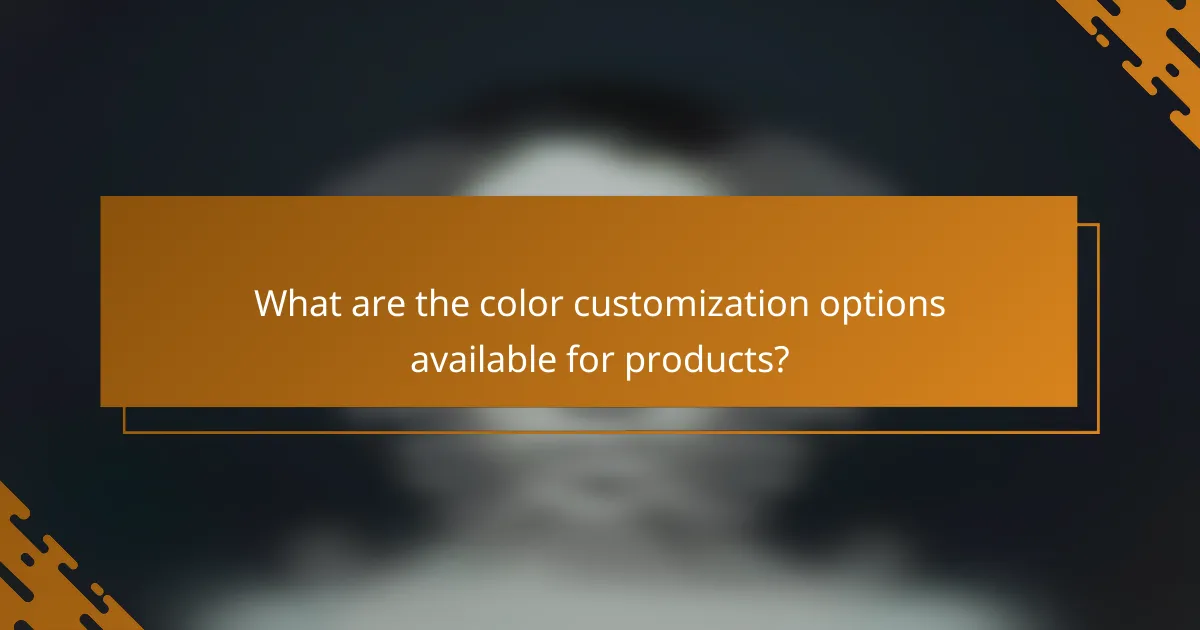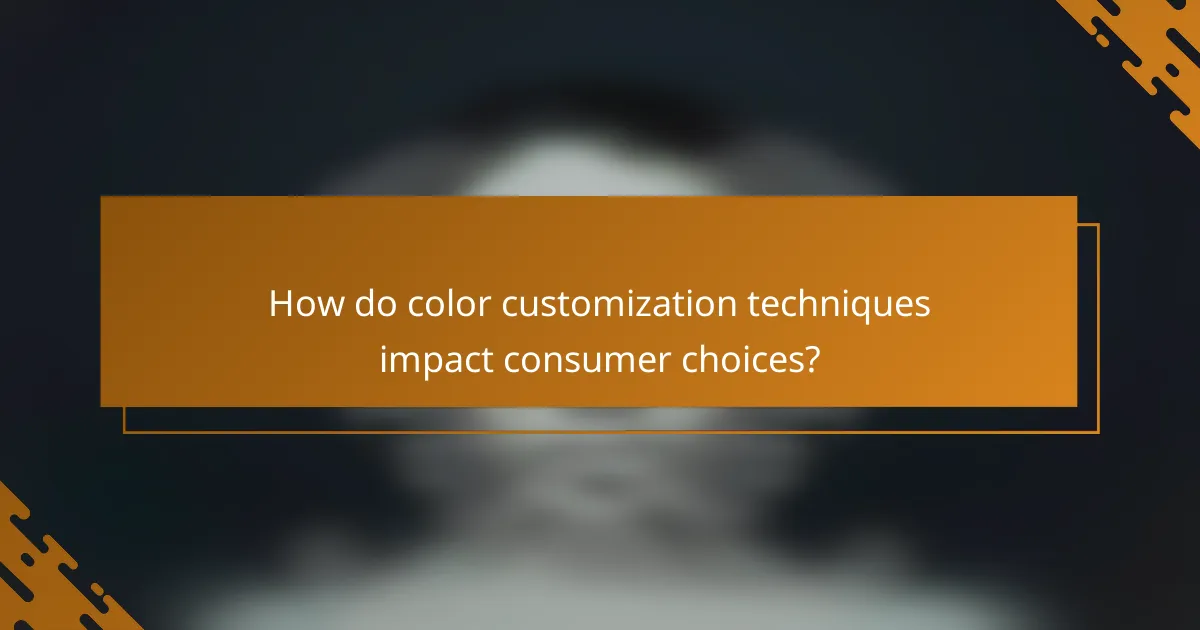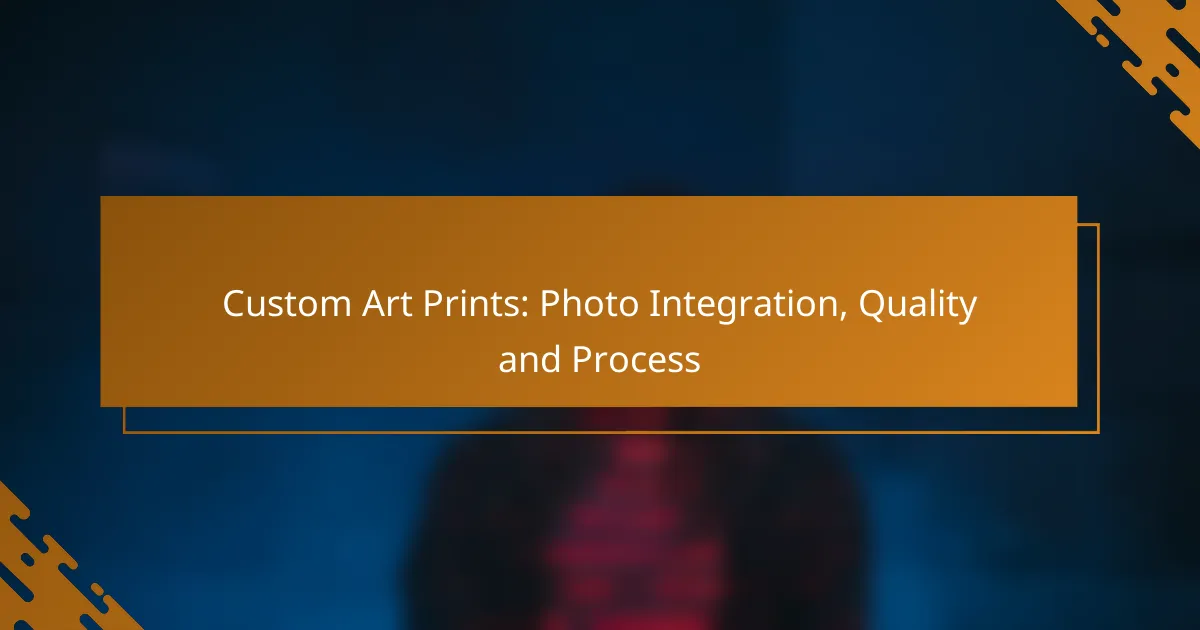Color customization has become an essential aspect of product design, offering various models and systems for precise color selection. By allowing consumers to personalize their choices, brands can significantly influence purchasing decisions and enhance emotional connections with their products. Implementing effective color customization techniques in e-commerce not only improves user experience but also drives sales through engaging and intuitive design interfaces.

What are the color customization options available for products?
Color customization options for products include various models and systems that allow for precise color selection and application. These methods enable businesses to create unique products that meet consumer preferences and branding requirements.
RGB color model
The RGB color model uses red, green, and blue light to create a broad spectrum of colors. This additive color model is commonly used in digital displays and design software, where colors are formed by combining different intensities of these three primary colors.
When working with RGB, it’s essential to understand that colors can appear differently on various screens due to calibration differences. For web design, using RGB values can help ensure consistency across digital platforms.
CMYK color model
The CMYK color model stands for cyan, magenta, yellow, and key (black) and is primarily used in color printing. This subtractive color model works by layering inks to absorb light and create the desired colors on paper.
When designing for print, it’s crucial to convert RGB colors to CMYK to ensure accurate color reproduction. Keep in mind that some vibrant colors in RGB may not be achievable in CMYK, so adjustments may be necessary.
Pantone matching system
The Pantone matching system (PMS) is a standardized color reproduction system that allows designers and manufacturers to communicate colors accurately. Each Pantone color is assigned a unique code, making it easy to specify and reproduce colors consistently across different materials and processes.
Using Pantone colors is particularly beneficial for branding, as it ensures that the colors remain consistent across various products and marketing materials. However, it’s important to note that Pantone colors may look different when printed on different substrates.
Hexadecimal color codes
Hexadecimal color codes are six-digit codes used in web design to represent colors. Each code begins with a hash symbol (#) followed by three pairs of hexadecimal digits that correspond to the red, green, and blue components of the color.
Hex codes are widely used in HTML and CSS, allowing for precise color selection in digital design. Familiarity with common hex codes can streamline the design process and ensure color consistency across web projects.
Custom color mixing
Custom color mixing involves blending different pigments or inks to create a unique color that may not be available in standard palettes. This technique is often used in art, design, and manufacturing to achieve specific shades or effects.
When mixing colors, it’s important to consider the medium (e.g., paint, ink) and the properties of the materials involved. Testing mixtures on sample surfaces can help ensure the desired outcome before final application.

How do color customization techniques impact consumer choices?
Color customization techniques significantly influence consumer choices by affecting how products are perceived and how they resonate emotionally with buyers. By allowing consumers to personalize colors, brands can enhance engagement and drive purchasing decisions.
Influence on brand perception
Color customization plays a crucial role in shaping brand perception. When consumers can choose colors that align with their personal preferences, they often feel a stronger connection to the brand. This can enhance brand loyalty and differentiate a product in a crowded market.
For instance, brands like Nike and Adidas offer customizable shoe colors, allowing consumers to express their individuality. This strategy not only boosts sales but also reinforces the brand’s image as innovative and consumer-focused.
Emotional responses to colors
Colors evoke specific emotional responses that can significantly impact consumer behavior. For example, warm colors like red and orange can create feelings of excitement and urgency, while cooler colors like blue and green tend to evoke calmness and trust.
Understanding these emotional triggers can help brands tailor their color options to resonate with their target audience. A study might show that products in calming colors perform better in health-related sectors, while vibrant colors may be more effective in the entertainment industry.
Color trends in e-commerce
Color trends in e-commerce evolve rapidly, influenced by cultural shifts and consumer preferences. Currently, there is a growing trend towards earthy tones and pastels, reflecting a desire for sustainability and comfort.
Brands should stay updated on these trends to remain competitive. Utilizing tools like color trend forecasting can help businesses anticipate changes and adapt their offerings accordingly. Regularly refreshing color options based on current trends can attract new customers and retain existing ones.

What are the best practices for implementing color customization in e-commerce?
Implementing color customization in e-commerce effectively enhances user experience and can lead to increased sales. Best practices include creating intuitive design interfaces, providing real-time color preview tools, and ensuring mobile compatibility.
User-friendly design interfaces
A user-friendly design interface is crucial for enabling customers to customize colors easily. Simplified navigation, clear labeling, and intuitive layouts help users feel more comfortable while selecting their preferred colors. Consider using drag-and-drop features or sliders to enhance interactivity.
Additionally, providing clear examples of color combinations can guide users in making choices that align with their preferences. Avoid overwhelming customers with too many options; instead, offer curated selections that highlight popular or trending colors.
Real-time color preview tools
Real-time color preview tools allow customers to see their selected colors applied instantly, which can significantly improve their shopping experience. These tools should be responsive and display changes without noticeable delays, ideally within low tens of milliseconds.
Incorporating 3D views or augmented reality features can further enhance this experience, giving customers a better sense of how the colors will look in real life. Ensure that these tools are easy to access and use, as complicated processes can deter potential buyers.
Mobile compatibility considerations
With a growing number of consumers shopping on mobile devices, ensuring that color customization features are mobile-friendly is essential. This includes optimizing touch controls and ensuring that the interface is responsive across various screen sizes.
Test your color customization tools on multiple devices to ensure consistent performance. Consider implementing larger buttons and touch-friendly sliders to facilitate easier interaction on smaller screens, as this can significantly enhance user satisfaction and conversion rates.

How can businesses measure the impact of color customization on sales?
Businesses can measure the impact of color customization on sales by analyzing conversion rates, customer feedback, and conducting A/B tests. These methods provide insights into how color choices influence purchasing behavior and overall customer satisfaction.
Analytics tools for tracking conversions
Utilizing analytics tools is essential for tracking how color customization affects conversions. Platforms like Google Analytics can help businesses monitor key metrics such as click-through rates and sales conversions linked to specific color schemes. By setting up goals and funnels, companies can directly correlate color changes with sales performance.
Consider using heatmaps to visualize user interactions on your website. This can reveal which color elements attract attention and drive engagement, allowing for informed adjustments to color strategies.
A/B testing color variations
A/B testing is a powerful technique for evaluating the effectiveness of different color variations. By presenting two or more color options to different segments of your audience, businesses can determine which colors lead to higher conversion rates. This method allows for real-time data collection and analysis.
When conducting A/B tests, ensure that the sample size is adequate to achieve statistically significant results. A common practice is to run tests for a minimum of one to two weeks to account for variations in customer behavior over time.
Customer feedback and surveys
Gathering customer feedback through surveys can provide valuable insights into color preferences and their impact on purchasing decisions. Questions can range from direct inquiries about color appeal to broader questions about overall shopping experience. This qualitative data complements quantitative metrics from analytics tools.
Incentivizing feedback, such as offering discounts or entry into a giveaway, can increase response rates. Aim for a diverse demographic in your surveys to ensure that the feedback is representative of your target market’s preferences.

What are the prerequisites for effective color customization?
Effective color customization requires a clear understanding of design principles, user preferences, and the context in which colors will be used. Familiarity with color theory and accessibility standards is essential to ensure that the chosen colors enhance usability and aesthetics.
Understanding Color Theory
Color theory is the foundation of effective color customization. It involves the study of how colors interact, the emotional responses they evoke, and their visual harmony. Key concepts include the color wheel, complementary colors, and color harmony, which can guide the selection of colors that work well together.
When customizing colors, consider using a color palette that includes primary, secondary, and accent colors. This helps create a cohesive look while allowing for flexibility in design. Tools like Adobe Color or Coolors can aid in generating appealing palettes.
Accessibility Considerations
Accessibility is crucial in color customization to ensure that all users can interact with your design effectively. This includes adhering to contrast ratios that meet WCAG (Web Content Accessibility Guidelines) standards. A contrast ratio of at least 4.5:1 for normal text and 3:1 for large text is recommended.
Testing your color choices with accessibility tools can help identify potential issues. Avoid using color alone to convey information; supplement it with text labels or patterns to ensure clarity for color-blind users.
User Preferences and Context
Understanding user preferences and the context in which colors will be viewed is vital for effective customization. Conducting user research or surveys can provide insights into color preferences that resonate with your target audience.
Additionally, consider the cultural significance of colors, as meanings can vary widely across different regions. For instance, while white is often associated with purity in Western cultures, it may symbolize mourning in some Eastern cultures. Tailoring color choices to the audience can enhance engagement and satisfaction.



